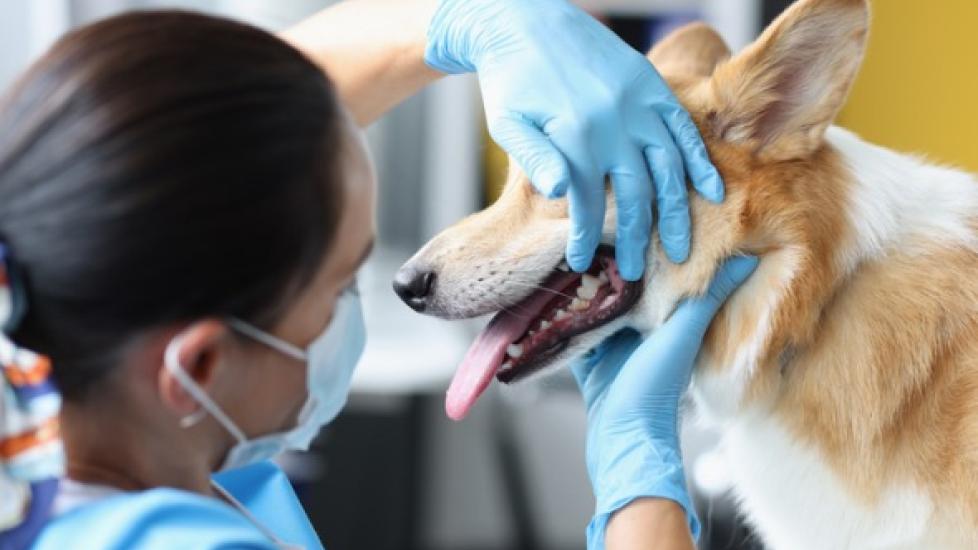Red Gums in Dogs
Red gums in dogs are usually a sign of a dental problem. A dog with good oral health has healthy pink gums, clean white teeth, and no signs of tartar buildup. No teeth should be loose.
When a dog’s gums begin to turn red, it could mean the beginning of gingivitis or periodontal disease. Red gums in dogs can also be caused by injury, ingesting something toxic, or overheating. In rare cases, the cause may be oral cancer.
Reddened gums may be tender and painful, so your dog may be reluctant to eat. If your dog has red gums, they should be examined by a veterinarian. Here’s some helpful info on red gums in dogs.
Health Tools
Not sure whether to see a vet?
Other Symptoms to Watch For if Your Dog Has Red Gums
Panting, lethargy, or head-tilting are more serious symptoms that could signal an emergency situation. See your vet if your dog has any of these.
Keep an eye out for some of these other symptoms that can occur with reddened gums, depending on the cause:
-
Tartar buildup and bad breath: signs of gingivitis or periodontal disease
-
Bleeding from the gums: sign of gingivitis, injury (such as from biting on a sharp object), or eating something toxic
-
Panting: sign of overheating
Cobbled texture: sign of warts or cancer
Causes of Red Gums in Dogs
Possible conditions that can cause red gums in dogs include:
-
Gingivitis and periodontal disease: With this mild type of gum disease, bacteria build up at the base of the teeth, forming tartar and plaque. This inflames the gums, but damage has not yet occurred to the tooth bone or ligaments holding the teeth in place. When gingivitis worsens, the gums become damaged.
-
Crowding teeth: If a young dog has too many teeth for the size of their mouth, their gums may become impacted and red.
-
Advanced age: With some dogs, their gums tend to turn red or even swell as they grow older.
-
Injury or trauma: Gums can swell and turn red when damaged by biting or being pierced by a hard, sharp object. This may be caused by poor chewing habits.
-
Toxicity: Your dog’s gums may turn cherry red if they consume something poisonous, such as eating a toxic plant or licking a poisonous toad.
-
Overheating and heatstroke: A dog’s gums may turn red if your pet is overheated or experiencing heatstroke. In this case, your dog may also be panting heavily.
-
Disease: Cancer, diabetes mellitus, or uremia (seen with kidney injury or urinary tract obstruction) can cause a dog’s gums to swell and turn red, and you’ll usually also notice other symptoms with each of these.
- Papillomatosis (warts on the gums): This usually occurs in younger dogs and in larger breeds, like Labrador Retrievers. The warts often fall off on their own.
Diagnosing Red Gums in Dogs
To determine why your dog’s gums have turned red, your veterinarian will examine their teeth and gums and do a complete physical exam. They may also perform the following tests:
-
Dental x-rays of the teeth and gums, which can determine if the cause is gingivitis, periodontal disease, or trauma. The exam may be done under anesthesia.
-
Blood and urine tests to check for an underlying medical condition
-
Tissue biopsy when conditions such as papillomavirus are suspected
-
Computed tomography (CT) scan or magnetic resonance imaging (MRI) exams to investigate more serious causes, like cancer
Treatment of Red Gums in Dogs
Treatment for red gums in a dog depends on the underlying condition diagnosed by your veterinarian.
Dental Issues
Your vet will treat dental problems like gingivitis by deep-cleaning your dog’s teeth to remove plaque and tartar. It’s important to maintain good dental hygiene with your dog all year long.
For more serious dental issues, periodontal surgery or tooth extraction may be recommended. Removing a tooth or teeth may be done to correct an overcrowded mouth.
Oral Issues
Red gums from oral lesions (like warts) may disappear on their own, but oral tumors may require surgery to remove.
Medical Condition
When red gums are due to a medical condition like diabetes, treatment will be based on addressing the specific condition.
Featured image: iStock.com/megaflopp
Red Gums in Dogs FAQs
What color is a sick dog’s gums?
Red, pale/white, blue, or yellow.
-
Red gums may indicate gum disease, injury, or many other conditions.
-
Pale white gums can indicate anemia.
-
Bluish gums may be due to a lack of oxygen.
-
Yellowish gums may be due to liver disease or bacterial infection.
Healthy gums should be pink.
How do I treat red gums in my dog?
You should not treat this at home. There can be many different causes for red gums in dogs, and only a vet can determine the underlying cause. The vet will determine the appropriate treatment after examining your dog. If dental problems are the cause, dental treatments and better hygiene may be recommended.
References
Help us make PetMD better
Was this article helpful?
